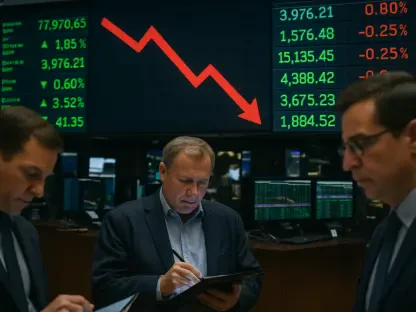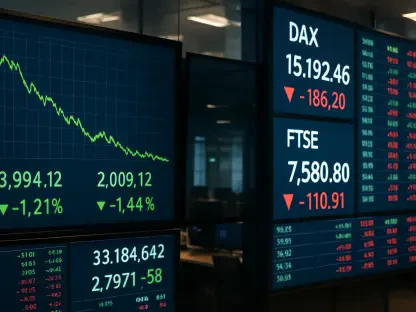Tether, the dominant force behind the world’s leading stablecoin USDT, has unveiled an ambitious plan to inject $1.5 billion into the commodity finance sector, marking a significant departure from its cryptocurrency foundation. This strategic move, spearheaded by CEO Paolo Ardoino, positions the company to revolutionize financing for trades involving vital goods such as oil, wheat, and cotton. It’s not merely a financial investment but a deliberate effort to address deep-rooted inefficiencies in traditional finance (TradFi) by merging blockchain technology with real-world markets. The potential to disrupt a sector long plagued by systemic challenges is immense, yet the path is fraught with complexities that Tether must navigate.
This bold pivot comes at a time when the intersection of digital assets and conventional financial systems is gaining traction. Tether’s initiative to support commodity trading through cash and stablecoin financing could redefine how smaller firms access capital in a market often overlooked by major banks. The implications of this venture extend beyond immediate financial gains, hinting at a broader transformation in global trade dynamics. As Tether steps into this unfamiliar terrain, the industry watches closely to see if blockchain solutions can truly bridge the gap between innovation and practicality.
Tether’s Strategic Vision
Diversifying Beyond Crypto
Tether’s commitment of $1.5 billion to commodity finance represents a pivotal shift from its core focus on cryptocurrency, aiming to carve out a significant presence in a crucial global industry. By targeting the trade of essential commodities like agricultural products and raw materials, the company seeks to harness its blockchain expertise to tackle persistent financial bottlenecks. This move is not just about expanding market reach; it reflects a deeper ambition to reposition Tether as a key player in the wider financial ecosystem. The integration of digital solutions into traditional trade financing could set a precedent for how technology reshapes entrenched systems, offering a glimpse into a future where decentralized tools play a central role.
Beyond the immediate goal of diversification, this strategy underscores Tether’s intent to address real-world challenges with scalable, tech-driven solutions. Commodity trading, often constrained by limited access to capital, presents an opportunity for Tether to fill a critical void. The company’s leadership appears confident that its stablecoin infrastructure can provide the speed and transparency needed to support traders who struggle under the weight of conventional banking limitations. If successful, this venture could enhance Tether’s reputation as an innovator capable of transcending the boundaries of digital currency markets.
Exploring New Revenue Horizons
Tether’s foray into commodity finance also signals a calculated effort to diversify revenue streams amid evolving dynamics in the cryptocurrency space. While USDT remains a cornerstone of digital transactions, branching into trade financing offers a buffer against the volatility and regulatory scrutiny often associated with crypto markets. This $1.5 billion investment is a bet on the stability of physical goods trading, which, despite its risks, operates on fundamentally different economic drivers than digital assets. The move could provide Tether with a more balanced portfolio, reducing reliance on a single sector.
Moreover, entering this market positions Tether to tap into a segment with vast global demand, as commodities form the backbone of international trade. By aligning with a sector that underpins economies worldwide, the company aims to build long-term resilience. The focus on essential goods trading also aligns with broader trends of financial inclusion, as Tether seeks to empower smaller players often sidelined by traditional institutions. This strategic expansion may well redefine how the company is perceived, shifting its image from a crypto giant to a multifaceted financial innovator.
Challenges and Innovations in Commodity Finance
Systemic Issues and Funding Gaps
The commodity finance sector is notoriously challenging, burdened by razor-thin profit margins and substantial risks such as counterparty defaults and unpredictable currency fluctuations. Smaller trading firms frequently find themselves squeezed out of funding opportunities because traditional banks hesitate to engage with a market characterized by volatility and logistical complexities. Cross-border transactions exacerbate these issues, introducing additional layers of regulatory hurdles and high interest rates that deter conventional lenders. Tether’s decision to step into this space is a direct response to these systemic gaps, aiming to provide an alternative that could stabilize financing for underserved players.
Beyond the financial barriers, the sector struggles with inefficiencies rooted in outdated processes and fragmented supply chains. Many traders rely on intermediaries, which inflate costs and slow down operations, further limiting profitability. Tether’s entry offers a potential lifeline by challenging the status quo with a model that prioritizes accessibility. If the company can navigate the inherent uncertainties of commodity markets, it might unlock new pathways for small- and medium-sized enterprises to thrive, addressing a critical need that has long been ignored by larger financial institutions.
Stablecoins as a Game-Changer
Tether’s innovative use of stablecoins like USDT presents a transformative approach to trade financing, promising faster, more cost-effective transactions compared to the cumbersome mechanisms of traditional banking. By enabling near-instantaneous settlements with minimal fees, stablecoins can significantly reduce the friction associated with cross-border commodity deals. This decentralized framework also diminishes dependence on intermediaries, cutting down on overhead costs and enhancing transparency for all parties involved. Such advantages position Tether as a potential leader in modernizing a sector ripe for disruption, with the capacity to redefine operational norms.
Additionally, the adoption of stablecoin technology addresses critical pain points like currency risk, a persistent issue in global trade. Unlike fluctuating fiat currencies, USDT maintains a stable value, providing traders with a reliable medium of exchange. This stability could encourage more firms to engage in international transactions without the fear of sudden financial losses due to exchange rate swings. Tether’s approach not only streamlines processes but also builds trust in a market often wary of innovation, potentially setting a new standard for how commodity finance operates on a global scale.
Risk Management and Market Entry
Safeguarding Core Operations
To mitigate the inherent volatility of commodity trading, Tether has established a separate investment arm dedicated to its finance operations, ensuring that its flagship stablecoin business remains insulated from potential setbacks. This structural decision, highlighted by CEO Paolo Ardoino, reflects a cautious yet progressive mindset, prioritizing the stability of USDT reserves while pursuing ambitious growth in a high-risk sector. By creating this clear delineation, Tether protects its core operations from the unpredictable swings that characterize commodity markets, demonstrating a commitment to responsible expansion.
This separation also serves as a safeguard against regulatory and operational challenges that could arise from entering an unfamiliar field. Commodity finance, with its complex legal frameworks and market-specific risks, demands a tailored approach that doesn’t jeopardize Tether’s primary revenue source. The distinct investment arm allows for focused risk assessment and management strategies specific to trade financing, ensuring that any turbulence in this new venture doesn’t spill over into the stablecoin ecosystem. Such foresight underscores a balanced strategy that values long-term stability over short-term gains.
Methodical Steps Toward Expansion
Tether’s journey into commodity finance has been anything but impulsive, with exploratory discussions with trading firms beginning in late 2024 to thoroughly evaluate the market’s intricacies. These preliminary engagements reflect a deliberate effort to understand the nuances of a sector vastly different from cryptocurrency, ensuring that the company’s strategy is grounded in practical insights. By taking the time to assess feasibility and build relationships with industry stakeholders, Tether demonstrates a commitment to entering this space with a well-informed plan rather than a rushed initiative.
Furthermore, this careful preparation highlights Tether’s awareness of the steep learning curve associated with commodity markets. Engaging with established traders provides valuable perspectives on regulatory expectations, risk factors, and operational demands that are unique to this industry. This methodical approach not only minimizes the likelihood of costly missteps but also positions Tether to tailor its financing solutions to the specific needs of the sector. As the company builds on these early conversations, it lays a robust foundation for a potentially transformative presence in global trade financing.









